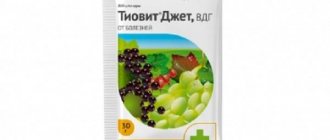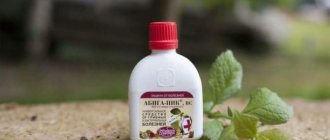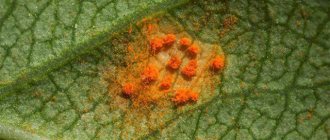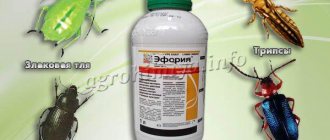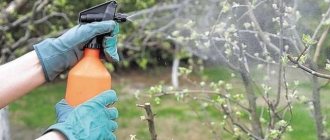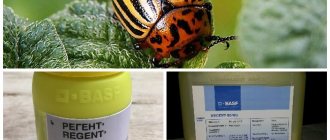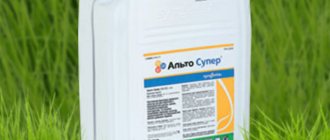Detailed description
"DNOC" is a complex preparation that combines the functions of an insecticide, fungicide and herbicide. The product is toxic and destructive to soil fauna. Great care must be taken when preparing the working fluid and spraying it.
The drug has a highly toxic composition. Treatment with the product should be no more than once every 3 years. "DNOC" provides comprehensive protection against diseases, fungal infections, pests, including ticks for the entire period. Most often, the composition is used to treat vineyards and garden trees in the first spring months, as well as after leaf fall.
Manufacturers use ammonium or sodium sulfate for filling. For industrial purposes, the drug is produced in the form of a yellowish powder in tightly packed cardboard reel containers weighing 20 kg. For retail sales, the production packages the composition in sealed plastic bags in 2 g quantities. The composition has a pungent chemical odor.
Dnok
To date, the drug has been withdrawn from registration
to replace it there is a drug "Brunka" follow the link
Strong supporters of the drug
Some gardeners are categorically committed to using the drug - those who have had to endure significant crop losses from pests. They willingly share information about how plants were treated using the Dnok product. The instructions were studied very carefully. For this category of users there is no alternative to this tool. As an argument in its favor, they put forward the claim that the composition of fertilizers is much more harmful to the health of both children and adults.
Even more categorical reviews contain the authors’ conviction that no other remedy can be compared at all - they characterize its effect on pests and pathogens as eradicating. Regarding its toxicity, the authors advise those in doubt to look around and pay attention to household chemicals that are used in every bathroom and kitchen, and inquire about the composition, as well as the characteristics of the effect on the human body.
The authors recommend that users carefully study the information on how plants are treated with the Dnok fungicide. The instructions (whether the product is used in the fall or spring, it doesn’t matter) contain detailed information about this process.
When using a toxic drug, you should take the necessary precautions.
Acquaintance
Practice has shown that “Dnok” is one of the most effective drugs for providing complete protection of vineyards and fruit and berry crops from pests, diseases, fungal diseases, mites, etc.
The use of a 1% concentration of the drug during the period of bud swelling does not affect the annual growth, does not have a negative effect on the condition of the leaves, and does not cause the ovaries of fruits and berries to fall off. Used to treat trees and vineyards in early spring and autumn.
The start time of the drug's effect is 3-4 days after spraying.
The protective effect lasts for 30 days.
Chemical composition, properties
· The formula of the fungicide “Dnok” is C7H6N205.
· The active ingredient is 4,6-dinitro-o-cresol.
· It is a potent, broad-spectrum pesticide with insecticidal, fungicidal and herbicidal properties.
· Highly effective, with long-lasting action (the use of 1 spraying of trees and shrubs can provide comprehensive protection for 3 years).
· It is poorly soluble in water, so organic solvents are used to dilute it.
Compound
It is important to calculate the correct concentration of the product. The solution, which contains 1% of the drug, is harmless to plants, including at the stage of swelling of buds and buds. Spraying with diluted liquid does not cause mutational changes in crops, leaf fall, or slower formation of ovaries.
The active ingredient of the drug is C7H6N2O5, called dinitroocresol. It is a broad-spectrum pesticide that can be used as a fungicide, herbicide and insecticide.
Attention!
The product is highly toxic. DNOC should not be used to treat small areas.
Terms of use
The effectiveness of the drug "DNOC" depends on the timely processing of fruit and berry crops. Experienced gardeners note only two periods suitable for spraying with fungicide.
Treatment in spring
Often, plants are treated with a fungicide in early spring, while the buds have not yet had time to bloom. You should wait until the frosts end and the temperature is not lower than +4 °C. It is important to carry out the treatment before the juices begin to flow, then the effect of the drug will be more effective. In addition, during this period it is easier to destroy insects that have not yet emerged from wintering. Before spraying, cover material should be placed on the ground to prevent toxic substances from getting into the ground.
Plants are treated with fungicide in early spring
Treatment in autumn
In autumn, the procedure is carried out less frequently and only after the plant has shed its leaves. The procedure differs from the spring procedure in several nuances:
- the ground is not covered, since the product must penetrate into the soil, where it will work as a pesticide;
- the solution must be made weakly concentrated;
- autumn tillage is harmless to the soil, as it does not affect its fertility in the next season;
- spraying plants before wintering will not adversely affect them in the spring.
Effect of the drug
The complex preparation “DNOC” is effective in combating not only mycelium and plant diseases, but also contributes to the death of pests. The product can be used against crop damage:
- scale insects;
- ticks;
- aphids;
- moth;
- leaf rollers;
- copperhead, etc.
The drug reaches its maximum concentration in the green parts of plants 2 days after treatment. The composition retains its protective and therapeutic effect on the culture for 1 month.
Composition of the drug "Dnok" and release form
The drug is produced in Ukraine. For those with an agrotechnical education, we will present the empirical formula of the active substance in the composition of the drug - C7H9N3O5. For those less knowledgeable on the topic, let us explain that the product contains a very strong substance - a pesticide - 4, 6 -dinitro-o-cresol, which has a hazard class of 2 according to its toxic characteristics.
For gardeners, the drug is available in plastic packaging in a volume of 50 grams. Such a small dosage is due to the maximum effectiveness of the drug, as well as increased toxicity.
The drug itself is a powder in the form of small granules, with a yellowish tint and a pronounced pungent odor. The powder is also explosive.
There are many opinions about the use of the drug. Thus, it is noted that it is unsafe. Experts in the field of pesticides note the inadmissibility of its use in sanitary zones, near water bodies, as well as within a kilometer from villages and settlements. Other reviews note the effectiveness of this product when used in industrial crop production, in particular in industrial vineyards and fruit and berry orchards. The cost-effectiveness of the product is also noted. Thus, one treatment in early spring or late autumn makes it possible to get rid of pests and diseases of fruit and berry crops for 3 years. It is for this period that the action of the fungicide is designed.
An important feature of “Dnok” is its poor solubility in water, in which case it is recommended to use organic solvents, for example, urea.
During the first day after treatment, the fungicide, penetrating the soil and plant, fights cells, spores and pests that cause diseases. The visible effect occurs already on the 4th day.
This fungicide is available under several trade names, such as “Sinox”, “Dinon”, “Celion”, “Crezot”.
Experienced agricultural technicians note that this drug is intended for use in large industrial farms. In small gardens and household plots, the use of the drug is impractical, and most importantly, unsafe.
It is also noted that even in industrial conditions the drug is used to prepare the soil for planting fruit crops. As a rule, soil disinfection with the drug is carried out in the fall.
What diseases can this product be used against?
It is advisable to use a solution of a drug with a wide spectrum of effects against diseases:
- gray rot;
- spotting;
- leaf curl;
- Clusterosporiosis;
- moniliosis;
- coccomycosis;
- scab;
- oidium;
- anthracnose;
- necrosis;
- cercospora;
- rust;
- powdery mildew;
- septoria.
Plants should be sprayed with a working solution of different concentrations against different types of diseases.
Benefits of use
It is advisable to use the drug “DNOC” due to the wide range of effects of the drug. The main advantages are:
- a large list of diseases against which the use of the product is effective;
- the drug is effective in combating most known pests, their larvae and eggs;
- it is possible to use the composition as a pesticide.
Instructions for use
The drug must be dissolved only in organic solvents. The composition is mixed unevenly with water. Spraying should be carried out in the first months of spring, even before the stage of bud swelling, in order to prevent infection by fungal pathogenic microflora and pest damage.
To prepare the working solution proceed as follows:
- mix the drug in an amount of 50-100 g in an organic solvent with a volume of 1-2 liters;
- the resulting emulsion is poured into 10 liters of water;
- mix the solution thoroughly.
An automatic sprayer is used for spraying. Spring treatment should include washing the trunks of fruit trees. This is necessary to destroy eggs and larvae of pests.
Instructions for use of the drug Dnok
In accordance with the instructions, “Dnok” (double blow) must be used during certain periods of the year. And also when preparing the fungicide solution, strictly adhere to the dosage.
When is the best time to treat with Dnok?
Spraying with “Dnokom” should be done in early spring and late autumn. In the first case, it is necessary to carry out treatment until the buds appear. Therefore, when the temperature reaches above zero, not lower than +4 degrees, a fungicide should be used. It is important to have time to carry out the treatment before the sap begins to flow, since it is at this time that the product shows maximum effectiveness.
Important! During spring treatment, it is impossible for the “Dnok” solution to flow onto the soil, so you need to cover the root circle with a film or tarpaulin in advance.
In the second case, the fungicide should be used after leaf fall and after all work with the soil under bushes or trees is completed, but the air temperature should not be higher than +5 degrees.
Application of "Dnoka" in the fall involves spraying the branches, trunk and top layer of soil with fallen leaves. For this treatment, it is recommended to use a 0.5-1% fungicide solution. At low air temperatures, the active component of “Dnoka” penetrates the soil to a depth of 7 cm and thus destroys pathogens and pests that overwinter not only on the plant, but also in the top layer of soil.
Important! When applying “Dnok” in autumn, the root circle should not be covered, since during this period the fungicide is not able to affect the fertility of the soil.
Preparation of the solution
To prepare the Dnoka working solution, you must initially pour 500 ml of warm water into a separate container, and then add 50-100 g of the drug powder to it, stir thoroughly. Then increase the volume of liquid to 10 liters.
The drug is poorly soluble in cold water
Rules for using Dnok
Depending on the type of crop, the fungicide needs to be used differently. If used in spring, the concentration of the active component should not exceed 4%, which is achieved by dissolving 400 g of powder in 10 liters of water. And during autumn treatment with “Dnokom” – no more than 1% based on 100 g of product per bucket of water.
Treatment of fruit trees with Dnok
The drug "Dnok" is recommended for use on stone fruit trees (apricot, plum, cherry, peach) and pome crops (apple, pear, quince).
Treatment should be done against the following pests:
- scale insect;
- types of ticks;
- slowpoke;
- leaf roller;
- mole;
- aphid;
- psyllid;
- moth.
Also, timely spraying of trees with “Dnok” helps to destroy pathogens of curl, spotting, clasterosporiasis, coccomycosis, moniliosis and scab. The consumption rate of the fungicide working solution is 10-15 liters per 100 square meters. m of plantings.
How to use Dnok for grapes
Before processing this crop, pruning should be done first. You must begin the procedure immediately after completing the preparatory stage.
Treating grapes with “Bottom” helps prevent the spread of mites, scale insects and aphids. As a fungicide, this drug is effective against:
- anthracnose;
- oidium;
- spotting;
- cercospora;
- necrosis.
The consumption of the Dnoka working solution in this case should not exceed 8 liters per 100 sq. m. m.
It is necessary to spray before the sap begins to flow in the plants.
Spraying berry bushes with Dnok
This drug is also recommended for processing gooseberries and currants. According to the instructions, it helps to get rid of:
- aphids;
- scale insects;
- leaf rollers;
- moth;
- false scale insects;
- ticks.
The use of this fungicide against diseases such as powdery mildew, septoria, rust, spot and anthracnose is also justified. The flow rate of working fluid when spraying shrubs should be within 15 liters per 100 sq. m. m.
Consumption rates
The consumption for processing fruit trees is 10 kg of dry matter per 1 hectare of plantings and for shrubs - 8 kg per 1 hectare.
| Culture | Disease | Pests | Consumption per 100 sq. m, l |
| Apricot, plum, peach, cherry | Spotting, leaf curl, clasterosporiosis, moniliosis, coccomycosis | Honeyweed, mites, leaf rollers, scale insects, moths, red-headed aphids | 10 |
| Quince, apple, pear | Moniliosis, scab, rot | Scale insects, psyllids, aphids, mites, leaf rollers, false scale insects, copperheads, moths, moths | 15 |
| Grape | Oidium, anthracnose, spotting, necrosis, cercospora | Scale insects, aphids, mites | 8 |
| Gooseberries, currants | Rust, spotting, powdery mildew, septoria, anthracnose | Leaf rollers, aphids, mites, scale insects, moths, false scale insects | 15 |
Terms and conditions of use
For processing fruit trees, berry bushes and grapevines, the following conditions should be taken into account:
- The ambient temperature should be in the range from +13 to +20°C. The use of the drug in other conditions is ineffective;
- It is not recommended to use the product with other drugs;
- You should not spray fruit crops and berry fields at rest. This can damage the bark and inhibit plant growth.
In spring, it is recommended to cover the soil under the treated plants with a covering material - tarpaulin or polyethylene. Autumn treatment, on the contrary, should facilitate the penetration of the product into the soil. Penetration of the drug to a depth of 7 cm has a pesticide effect. Using DNOC in the fall will not affect soil fertility and will not have a detrimental effect on plants in the next season.
Where is it used?
Dnok provides maximum plant protection, which is why it is the most common preparation. At the same time, there is a passionate debate going on: is it possible to use such a poisonous product in a private garden.
Many experienced summer residents give good reviews and advise it to beginners, but at the same time they warn that high efficiency also has a downside.
The instructions clearly indicate that the drug Dnok is allowed for use only in gardens and vineyards belonging to large farms. It cannot be used on personal farmsteads and in dacha cooperatives.
The fact that the product is packaged in 50 g bags suggests that the manufacturer of the pesticide intends to use it not only on an industrial scale, although the instructions strictly prohibit this.
Dnok is sold in regular stores for gardeners and gardeners. Its area of application is fruit trees, berry bushes and grapes.
Precautionary measures
The complex action drug “DNOC” is highly toxic. It is imperative that all work is carried out in compliance with safety precautions when working with chemicals. Observe the following precautions:
- wear special clothing both for preparing the working solution and for spraying plants;
- be sure to use gloves, goggles, a respirator or gas mask, and rubber boots;
- After work, you need to wash all protective equipment;
- you need to monitor your well-being while working with liquid;
- strictly follow the recommended concentration and rules for preparing the solution;
- do not work with the product for more than 2 hours;
- leave protective clothing and personal equipment in a special utility room;
- use a separate container to prepare the solution;
- if the composition gets on the skin or mucous membranes, you must immediately seek medical help and rinse the affected area with running water;
- It is prohibited to use the drug and prepare the solution indoors;
- work cannot be carried out near a residential area;
- Do not prepare the liquid and carry out processing near open fires, bodies of water, or sources of drinking.
Attention!
It is forbidden to take the clothes in which you sprayed with unprotected hands.
